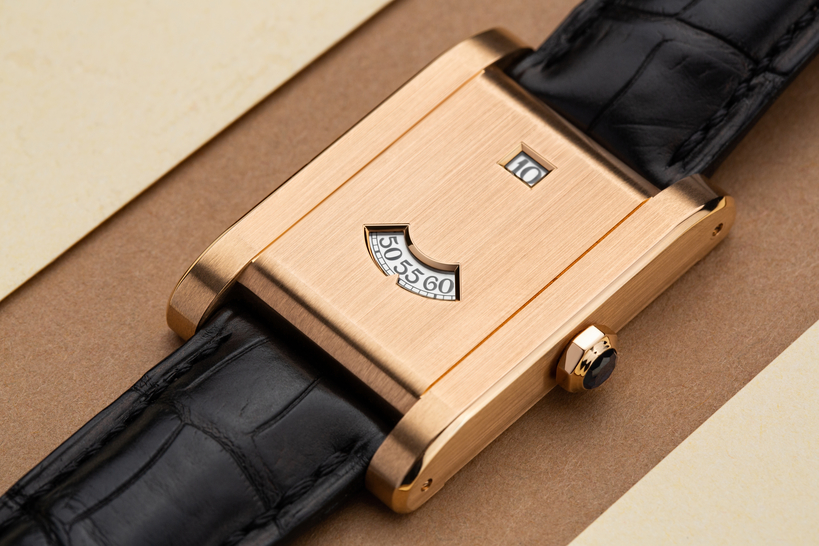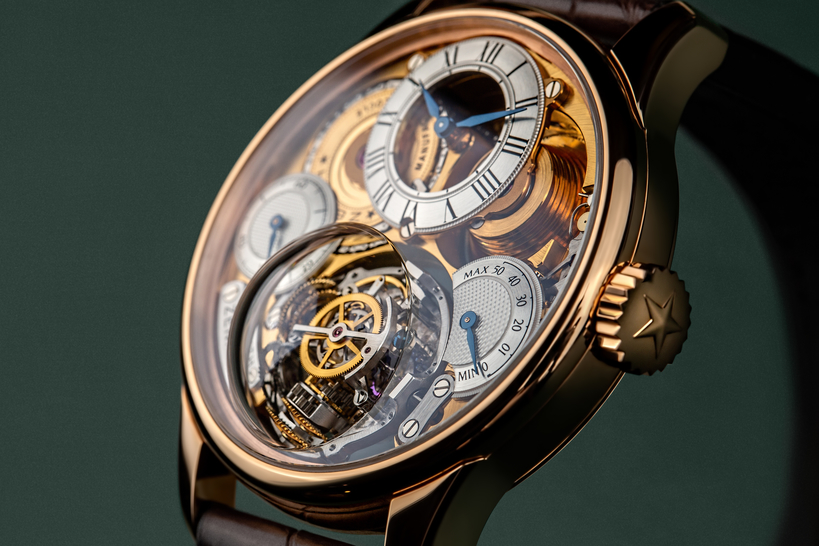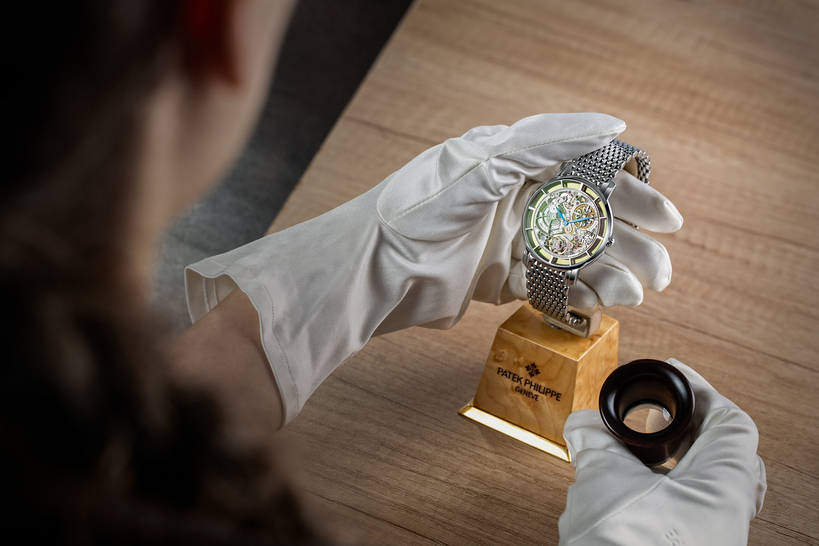This article provides our pick of the most interesting complications.
Before we begin discussing new complications, let's not forget that complications and watch functions aren't the same thing. Every complication serves a function, but not every function is a complication. Some examples of watch functions that aren't complications would be a waterproof screw-down winding crown and chronograph push-pieces.
An automatic helium escape valve, an anti-magnetic case design, or a tachymeter scale on the periphery of the dial. The only functions that qualify as complications are those that make the basic watch movement more complicated and add an extra load onto it.
TIME DISPLAY
Every watch can be divided into three components — energy storage, energy distribution, and the indication of time. Let's begin by focusing on the latter and how time is displayed (an article about technological revelations has already been devoted to the first two components).
Digital Disk Display
In 2003, the Harry Winston Timepiece Division opened the third chapter of its landmark Opus series first launched by Maximilian Büsser in its third year. The Opus 3 created by Vianney Halter was the first watch in the history of watchmaking with disks used for a digital display.
The watch even worked for a while, but it didn't run for long due to the huge amount of energy it needed to consume to make the six discs turn. In the end, no conclusive solution was found to the problem with power reserve, but the attempt still counts.
Watchmakers in the Saxon town of Glashütte and the birthplace of the German watchmaking industry came much closer to finding a solution to this problem.
A. Lange & Söhne Zeitwerk (2010) provides an exemplary solution to the problem of storing and distributing energy in order to allow the numeral disk to jump for every new minute. The thinnest of disks are used which are almost weightless, and the jumping numerals mechanism has no effect on the balance whatsoever.
Digital Display
For the 15th anniversary of de Grisogono in 2008, the brand's founder Fawaz Gruosi presented what is perhaps the most amusing mechanical watch — the Meccanico dG with a traditional analog face and a digital display.
The mechanism built on a standard mechanical movement displays the time like a quartz watch. Oddly, enough, the idea apparently came from one of the brand's clients, who once mentioned in a conversation with Mr. Gruosi that it’d be great to wear a mechanical watch that displayed the time just like a Casio!
Gruosi made his client's dream come true. The added level of complexity in the mechanical movement meant that there weren't enough Meccanico dG models released, so you could say it's quite the rareity.
Belt Display
The Swiss watchmaker Christophe Claret, who created complications for many watch manufacturers, founded his own manufacture in 2009 and introduced the Christophe Claret DualTow model with an original way of displaying the hours and minutes using vertical rolling rubber belts, like the tracks that tanks roll on for mobility.
The planetary-gear array connected to the hour and minute wheels move the rollers to keep the belts in motion. It's a captivating idea, but one that drains a lot of energy.
Magnetic Display
In 2012, Claret took his creative idea of alternative transmission displays a step further. Two hollowed steel spheres were isolated within sapphire crystal tubes, which float up and down freely most of the time.
Before you can tell the time, the case first needs to be held in a horizontal position, then the watch needs to be slowly and steadily tilted to an angle greater than 45 degrees. The magnets hidden under the dial will move alongside the tubes, and can attract and hold the spheres in place.
It works every second try. Accuracy is plus / minus 5 minutes, despite the fact that the escapement is enclosed in a tourbillon carriage. Overall, this isn't a watch, but a shameless way of conning clients out of their hard-earned.
Another invention by Christophe Claret from 2015 is the Marguerite model with a mechanism in the shape of a daisy for playing the fortune-telling game "he loves me, he loves me not”. Could this be considered a complication?
Surely not, similar to the other watches with random mechanisms that play with chance and fortune, like the Richard Mille RM 69 Tourbillon Erotic, Jacob & Co Astronomia Casino, Girard-Perregaux Vintage 1945 Jackpot Tourbillon and the ArtyA Russian Roulette.
Liquid Display
People have used liquid-filled tubes as indicators for a long time. They're not much younger than mechanical watches. Concord CEO Vincent Perriard put the idea to use in 2009 when he first introduced the Concord C1 Quantum Gravity model that uses liquid to indicate power reserve.
The company went bankrupt not long after. Perriard became CEO of the watch brand HYT in 2012, and invited the same team of engineers and designers to come join him, who soon developed a fluid cell indicator for the HYT H1 model.
Mechanical energy from the movement is converted into isostatic energy by a complex cam-follower transmission system. Not only is this idea a fascinating execution of design, there's certainly a place for it in the future, and not necessarily limited to marking the hours.
CALENDARS
The greatest number of revelations have involved mechanical calendars. Here are the main ones.
Four-Year Calendar
Rolex presented the Oyster Perpetual Sky-Dweller and Breitling presented the Navitimer at Baselworld 2012, both with calendar mechanisms that run on four-year cycles, i.e. they only require adjustment once every four years. What sets them apart for watches that need to be adjusted on an annual basis is that they roll right back from the 28th to the 1st at the end of each February without reminders.
Owners only need to manually adjust the calendar on leap years for February 29. They weren't named quadrennials so that they wouldn't be confused with leap year indications in watches with a perpetual calendar, which are often referred to as such.
Business Calendar and Hebrew Calendar
These two calendars have been combined thanks to Vacheron Constantin. The manufacturer presented world's the most complicated watch with 57 functions and complications called Reference 57260 in 2015, the year the brand marked its 260th anniversary. These calendars made their debut in this watch, commissioned by a client who wished to remain anonymous.
The Hebrew perpetual calendar's main difference is that it's based on the 19-year Metonic cycle equal to exactly 235 lunations or synodic months, which can be rounded up to 6940 days. Lunar and solar eclipses, the Holy day of Yom Kippur and Easter are calculated according to this calendar. For your information, now it's the year 5781.
It also featured the world's first business calendar in a watch, compliant with the calendar-and-clock format standard ISO 8601. This system was created by the International Organization for Standardization and is used in the financial sector for annual reports, payroll, and rent payments.
And while we're here, it's worth mentioning that this was also the world's first watch to feature a new system to manage the striking mechanism, with the option of choosing a single hammer or Westminster carillon full chiming alarm mode, or an automatically disabling "night silence" mode.
1000-Year Calendar
In 2006, the second version of Franck Muller's Aeternitas Mega model was released. While the first model was notable for its huge tourbillon, the second watch had a perpetual calendar that takes into account the rules governing the Gregorian calendar we're familiar with, including the notable exception about centurial years not being leap years unless they can be divided by 400 (i.e. it doesn't need to be adjusted in the year 2100). The calendar consists of three sets of wheels for a 10-year, 100-year and 1000-year cycle.
Religious Calendars
The first person to succeed in creating a wide range of complex religious calendars was the Russian master watchmaker Konstantin Chaykin. In the early 2000s, Chaykin designed and created Islamic calendars and sold the patent to use them to Buben & Zorweg. Chaykin's system for the Islamic calendar acts as a biennial calendar.
Which means it needs to be manually adjusted every two years — in the leap years of the Hijri calendar leap-year cycle. At the same time, the lunar calendar works based on both a 30-year periodicity (“Arabic cycle”) and a 8-year periodicity (“Turkish cycle”).
Konstantin Chaykin later invented two mechanisms for calculating and indicating the moving date of Eastern Orthodox Easter. He made the first "Paskha Khristova" Orthodox Easter computus clock in 2005.
In 2007, Konstantin Chaykin developed a far more complex timepiece for indicating the date of Orthodox Easter by purely mechanical means, using the eccentric's computus mechanism comprised of a triad of cam wheels, springs, levers, racks and three differential gears.
This was the first of its kind in the history of watchmaking, and one of the most complicated mechanisms for driving a single hand, which was put into action in the "Resurrection Computus Clock" (2007). Finally, Chaykin has gone down in history as the inventor of the "Shabbat" function in the Jewish calendar.
On Shabbat, Jews are prohibited from performing 39 categories of melacha (work). Chaykin's "Shabbat" clock saves its owner from having to wind the clock on this day (the patented additional winding startup device guarantees that the clock won't stop running until the end of Shabbat, or else it'll stop running 5-6 hours before the Shabbat begins).
The "Shabbat" function is a logical mechanical device, a mechanical computer of sorts, which analyzes the state of both the calendar and the mainspring barrel, and then it decides based on this information whether or not to let the clock run on Shabbat.
In 2008, Chaykin was also the first to invent an analemma indicator, a module which displays the Sun’s deviation from its average motion in an imaginary trajectory across the sky. If you mark the position of the Sun at the same time every day over the course of a year, its trajectory will form a figure eight pattern — the symbol of infinity.
The analemma mechanism also allows you to determine the current date according to the position of the Sun in the sky, calculate the equation of time, determine the moment when the summer and winter solstices occur, as well as the Sun's angle of declination.
Big Month Display
In 2009, the IWC manufacture in Schaffhausen presented a large digital month display made to mirror the "big date" aperture in the Da Vinci Perpetual Calendar Digital Date-Month model. The company's master watchmakers repeated a similar aperture to the ones invented in 1884 for pocket watches by the Austrian master Josef Pallweber.
The 89 800 automatic manufacture caliber has a mechanism which accumulates energy throughout the month, so the new mechanism has almost no affect on the movement's accuracy when the large double-digit displays for the date and month need to turn over at the end of each month.
Wristwatch Planetarium
The most visually stunning wristwatch planetarium was created by Dutch master watchmaker Christiaan Van Der Klaauw for Maison Van Cleef & Arpels, famous for its luxury jewelry and watches. The dial of the Midnight Planétarium Poetic Complication model is a clockwork model of the solar system with planets orbiting around the Sun.
It consists of disk rings that vary in size, which rotate around their axis at different speeds. Of course, the turquoise sphere representing the Earth makes one complete revolution every year, the disk with Saturn completes a circuit of the dial every 29 years, and Mars completes one every 687 days. The Planétarium also has an extra feature called "lucky day".
This day comes once every year, and can be set by rotating the red triangle on the bezel against a graduated calendar. The Earth will be directly below a lucky star rotating around the dial’s circumference when that day arrives. There are apertures on the caseback side which indicate the date, weekdays and months. These can be adjusted using the push-pieces on the side.
Mareoscope
This is essentially a combined tide level indicator and moon phase display, showing the relationship of the Sun, Moon, and the tides as well. The Mareoscope is positioned in a window between the 10 o'clock and 11 o'clock on the dial of the unique 2017 Vacheron Constantin Les Cabinotiers Celestia Astronomical Grand Complication 3600.
There's a hemispherical cut-out rose-gold Sun in the corner of the Mareoscope window. Planet Earth is in the center made of blued steel with the Moon orbiting around it. The sector's graduated scale is positioned to the right, which which rotates beside a gold arrow that indicates the intensity and strength of ocean tides.
The day/night and tide level indicator in the Ulysse Nardin Moonstruck model is a simply fascinating and exquisite thing, but it's still nothing new in the strictest sense.
CHRONOGRAPHS
Watchmakers have also been working hard to improve what is one of the most useful and popular watch functions. Saxon watchmakers A. Lange & Söhne have excelled the most in this area. In 2004, the masters from Glashütte introduced the A. Lange & Söhne Double Split with the the worldʼs first mechanical chronograph with a double-rattrapante function and a 30-minute counter.
Previously, owners of split chronographs could only compare the difference in duration between simultaneous processes lasting no longer than one minute. Then in 2018, the A. Lange & Söhne Triple Split was released with an additional rattrapante mechanism for hours and a 12-hour counter. These were surprisingly complicated and useful innovations.
In 2013, Jaeger-LeCoultre marked its 180th anniversary and presented the Master Grande Tradition Gyrotourbillon 3 model. Its main attraction was of course its tourbillon, but it was also the world premiere of a chronograph with a digital minute counter — an elegant bow of sorts to fans of the Grande Maison, taken by the masters after the grand finale.
In 2017, Ulysse Nardin showcased the world's first unique Marine Regatta reversed chronograph / countdown regatta timer, including an inverter mechanism with a bi-directional second hand that can rotate in the opposite direction to the minute hand. This counter is designed to count down the minutes before the yacht race begins, made to measure up to 10 minutes.
After the countdown the regatta begins and the normal chronograph automatically kicks in, which can measure up to 12 hours. The pre-race counter scale divides the minutes into four 15-second intervals. The countdown mechanism is created to mirror a chronograph, with its ring gears rotating in the opposite direction.
WORLDTIMERS
Jet Lag Indicators
Changes in lifestyle in the era of globalization have sparked a trend for world-time watches with multiple time zone indications. Manufacturers remained satisfied with Louis Cottier's universal worldtimer watches for decades after they were invented in the first half of the last century, which had a rotating 24-hour ring with names of different cities around the outer dial inside the bezel.
This complication was further supplemented by a day/night indicator and the summer and winter time function to account for daylight saving time. It wasn't until 2011 that two models were released in the same year with a previously unheard of complication called the jet lag indicator. Moreover, both were apertures located on the edge of the case with a numerical indication of the difference between time zones.
These were the Rotonde de Cartier Multiple Time Zone watch and the Breguet Classique “Hora Mundi”. Both mechanisms were so complex that Breguet decided to do away with it in 2016 in its next version of the "Hora Mundi". Michael Vogt's world timepiece mechanism used in watches by Vogard and IWC is original, but it belongs to the list of functions, not complications.
This list also includes the mechanical golf stroke counters in watches by Omega, Franck Muller, Hublot, Oris, Romaine Gerome; the mechanical altimeters in Breva watches; and speedometers in watches Breva made with Porsche Design.
THE EXOTIC
All the other new arrivals in functional complications can be categorized as exotic. Even seemingly fundamental complications such as the balance frequency switch in the Vacheron Constantin Traditionnelle Twin Beat belong to this category.
The recommendation is for the watch to be worn in the high-frequency Active mode of 36,000 vph (5 Hz), and for it to be stored in the low-frequency Standby mode of 8640 vph (1.2 Hz) to reduce friction and save lubrication.
In 2001, year one of the third millennium, Audemars Piguet unveiled what can now be referred to as the legendary Royal Oak Concept Tourbillon. It debuted features such as the now rather prestigious dynamographe to display the torque supplied by the mainspring from the winding crown which effects accuracy, as well as the crown position indicator.
Those of us who like to be extremely punctual will appreciate the former, while people who are quite forgetful will appreciate the latter. Together with Giulio Papi, they happen to be invented by Richard Mille, who was still an unknown novice at the time.
These functions are now signature features of Richard Mille watches. In 2013, he also invented the G-force sensor to gage whether deceleration is safe or critical (the G-Force meter) used in the RM036 G-Sensor Tourbillon Jean Todt.
Maison Van Cleef & Arpels, famous for its luxury jewelry and watches has formed a perfect partnership with the amazing master Jean-Marc Widderrecht from Hermès, also the owner his own company called Aghenor. His models with Pont des Amoureux indicating the time for a romantic rendezvous are simply charming, as is the Hermès Arceau Le Temps Suspendu with hour and minute hands that merge into one.
Then there's also the second hand which begins rotating counterclockwise at a speed of 1 revolution per 24 seconds when you want to forget about everything going on around you and focus on enjoying a passing moment of pleasure.
It's not even possible to come up with an accurate name to describe this complication. Given that Monsieur Wiederrecht is constantly thinking about time in unorthodox ways, we can expect to see many more similarly amazing complications.

























